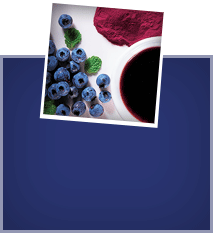Here are answers to your questions about Wild Blueberries, their health and nutritional benefits, and where to find them.
Discover Why Wild is Simply Better
Where do Wild Blueberries grow?
Wild Blueberries thrive in the glacial soils and northern climate of the special place we call the Land of Wild Blueberries – Atlantic Canada, Quebec and Maine.
Wild Blueberries are one of three berries native to North America — what are the others?
Like Wild Blueberries, Concord grapes and cranberries have grown naturally for thousands of years.
How are Wild Blueberries harvested?
Wild Blueberries are often harvested the traditional way, with hand-held berry rakes that have been used for generations. Within hours of being picked, the berries are sorted, cleaned and processed, using state-of-the-art technology to preserve their flavor, quality and goodness.
How are Wild Blueberries different from cultivated blueberries?
Wild Blueberries (vaccinium angustifolium) are distinct from their cultivated cousins in several significant ways. Unlike cultivated (highbush) blueberries, Wild (lowbush) Blueberries are not planted. They are spread primarily by rhizomes or underground runners, which give rise to new shoots and stems. Wild Blueberry fields and barrens contain many different varieties of berries, which accounts for the variations in size and color that characterize the Wild Blueberry crop. Wild Blueberry growers use many modern crop management techniques to carefully tend their fields and encourage growth.
Other differences include:
- Antioxidant capacity – Wild Blueberries contain more of the powerful anthocyanin and demonstrate greater capacity per serving than cultivated blueberries.
- Taste – Wild Blueberries have a more intense, sweet and tangy taste than cultivated blueberries
- Size – Wild Blueberries are naturally smaller and more compact (less water content) than cultivated, which means you get more Wild Blueberries per pound.
- Performance – Wild Blueberries hold their shape, texture and color through a variety of baking and manufacturing process. They also freeze very well: IQF Wild Blueberries maintain their quality for more than two years.
Wild Blueberry Health
What do anthocyanins do?
We all know how delicious wild blueberries are. Many people don’t realize it, but there’s a link between brain health and cardiovascular health. What’s good for your brain is good for your heart. See what the science says about the disease fighting potential of wild blueberries. https://www.youtube.com/watch?v=bJfhZp-laqI
What does that mean for me?
It means that a 125 ml (½ cup) serving of Wild Blueberries has more of the anthocyanin power you need to help fight cancer, heart disease, short-term memory loss and other effects of aging than many other fruits and vegetables.
What is anthocyanin and why is it important?
Anthocyanin is a powerful pigment responsible for the intense blue and red pigments of fruits like Wild Blueberries. Anthocyanin is believed to protect against brain aging and promote vision health. In addition to reducing eye strain and improving night vision, scientists are examining the ability of anthocyanin-rich Wild Blueberries to prevent macular degeneration, the leading cause of blindness in people over age 65.
How do Wild Blueberries help fight the effects of aging?
In the first human study of its kind, researchers demonstrated that anthocyanin-rich Wild Blueberries are highly beneficial in maintaining memory function. The study, conducted by a team led by Dr Robert Krikorian at the University of Cincinnati, confirmed that Wild Blueberry supplemented diets improved memory function and mood in older adults with early memory decline. (Journal of Agricultural and Food Chemistry. 2010; 58, 3996-4000)
What role might Wild Blueberries play in preventing cancer?
Studies conducted by Mary Ann Lila Smith, Ph.D, Department of Natural Resources and Environmental Sciences, University of Illinois, Urbana-Champaign, indicate that compounds in Wild Blueberries may be effective inhibitors of both the initiation and promotion stages of cancer. (Journal of Food Science, Vol. 65, No. 2, 2000)
Can Wild Blueberries help protect against urinary tract infections?
Yes. At the Rutgers University Blueberry Cranberry Research Center, Amy Howell, Ph.D, showed that blueberries, like cranberries, contain compounds that prevent the bacteria responsible for urinary tract infections from attaching to the wall of the bladder. (New England Journal of Medicine, October 9, 1998, Volume 339, Number 15)
Wild Blueberry Nutrition
Why is eating colorful foods, like blueberries, such a hot topic?
Scientific research is showing that many of the very chemicals, known as phytochemicals, that give fruits and vegetables their color are good for us.
What’s more, The Color Code, a new book available nationwide, explores the powerful connection between the color of foods and optimum health. According to James A. Joseph, Ph.D., one of the book’s authors, “Incorporating colorful fruits and vegetables into a daily eating plan may be the best defensive strategy for fending off many diseases of aging such as cancer, heart disease and dementia.”
Wild Blueberries are a “nutrient-rich” food. What does that mean?
At just 80 calories per 250 ml (1 cup) serving, Wild Blueberries deliver substantial nutrients for every calorie consumed. That makes them a nutrient-rich choice for your daily diet.
What are Canada’s Food Guide recommendations for healthy eating?
The Food Guide clearly recommends eating more fruits and vegetables every day. Depending upon your age group and sex, the guide specifies between 4 and 10 servings of vegetables and fruits per day. Just 125 ml (½ cup) of Wild Blueberries is considered a serving.
Are frozen berries as nutritious as fresh ones?
Frozen fruits and vegetables are just as healthy as fresh and many even retain their nutritional value longer. That’s good news for Wild Blueberries, which freeze extraordinarily well.
Wild Blueberry Availability
Where can I buy Wild Blueberries and when?
Wild Blueberries are available year-round. Consumers can buy them at their local supermarkets in frozen, canned, jarred, dried and fresh forms. For the trade, Wild Blueberries are also available in concentrate, purée, powder and extruded forms.



